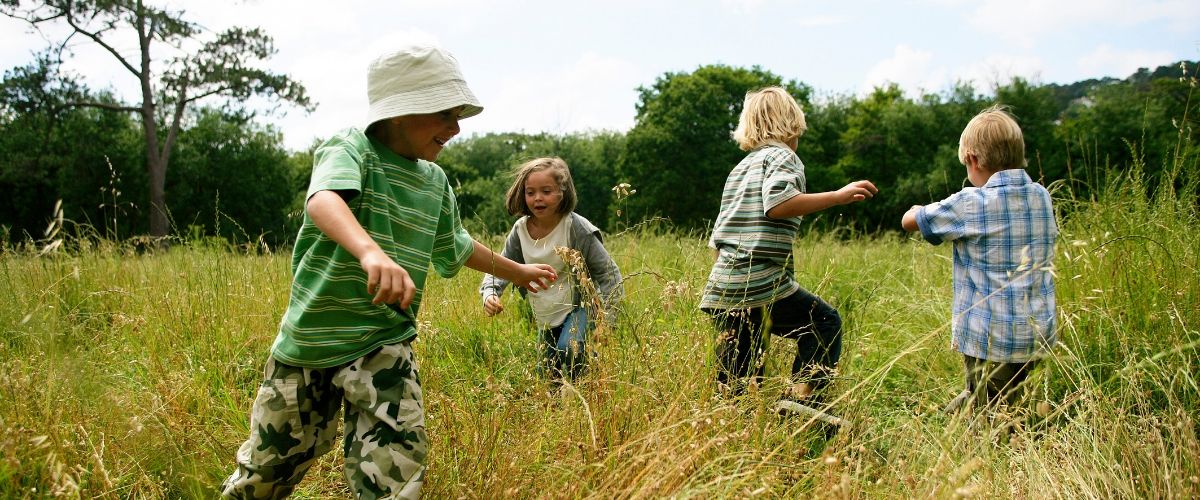
There are two main factors as to why children get Lyme disease. First… children are close to the ground and second, they like to play outdoors, especially boys. Both points can increase their chances of being bitten by ticks.
Most Lyme cases in children tend to occur between ages 5 and 9, states the CDC, and boys are more likely to contract Lyme disease than girls in the U.S.
Ticks don’t live on bushes and drop onto victims. They live in grass mostly and children love to play and roll on the ground. When ticks hitch a ride on a host they climb until they find a warm safe spot to have a meal of the victim’s blood. This is usually the groin, armpit or a fold in the skin.
“They will cling to tall grass, brush and shrubs, usually no more than 18-24 inches off the ground. They also live in lawns and gardens, especially at the edges of woods and around old stone walls.” (health.ny.gov)
Bull’s-Eye Rashes May Be the Exception, Not the Rule
Dr Charles Ray Jones, a well-known pediatric Lyme specialist who has treated more than 15,000 children and adolescents has said that the EM rash was only present in under 10% of his patients.
Children with Lyme disease can often look well even while suffering a myriad of symptoms. Often these sick children aren’t believed by peers, teachers, doctors, and even family members.
The Accepted Traditional Testing Methods are Unreliable
Tests like the ELISA and the Standard Western Blot have low sensitivity and can miss a large percentage of children who have been infected with Lyme disease. What does this mean? It means a child could have a negative test and still suffer Lyme disease.
Another problem in Australia occurs because Lyme Disease is not found here according to the government and any positive tests must be false readings.
Clinical observation is usually the best indication of Lyme based on a child’s clinical presentation, symptoms, the potential for exposure to ticks, and medical history.
Symptoms Are Unpredictable and Varied
As with adults, Lyme disease can affect any organ, joint, or tissue in their body. It’s not unusual to see children’s symptoms range from joint pain and fatigue to neuropsychiatric manifestations like mood swings, aggression, obsessive-compulsive disorder (OCD), and more.
Lyme Disease May Lead to Childhood Neuropsychiatric Disorders
Lyme disease is one of several infections that can act as a trigger for a constellation of neurological symptoms known as PANS (pediatric acute-onset neuropsychiatric syndrome) and PANDAS (pediatric autoimmune neuropsychiatric disorders associated with streptococcal infections). Children with PANS/PANDAS can exhibit tics, obsessive-compulsive disorder, attention deficit disorder (ADD), depression, anorexia, and more.
“In my experience, kids can present with regressive behaviour, trouble interacting with peers, and issues with schoolwork,” says Dr Elena Frid. She goes on to say “About 50% of children I see are not able to attend school full time.”
Symptoms to Look for in Your Child
Symptoms in the early stage of Lyme Disease occur around three to 30 days after being bitten and infected. Most initial symptoms are mild — Your child might exhibit flu-like symptoms like fatigue, headache, fever, body aches, and chills. As mentioned before a rash may or may not show up. A bullseye rash is considered definite for infection with Lyme disease, however, other types of rashes can also indicate infection.
If you observe flu-like symptoms in your child during the summer months it may be advisable to think that something else may be going on, especially if your child is spending time outside.
A child suffering from chronic Lyme disease may have a host of seemingly unrelated symptoms. Many health conditions are mimicked by Lyme. Following is a list of common symptoms:
- Fatigue, exhaustion, or poor stamina
- Joint pain that travels to different areas on the body without a known injury
- Muscle pain
- Muscle weakness
- Headaches, including migraines
- Fevers
- Night Sweats
- Changes in sleep habits, either too much or too little
- Abdominal pain
- Changes in urinary habits, like increased urinary frequency or inability, to hold urine
- Personality changes like irritability, impulsivity, mood swings, depression, anxiety, anger, or rage
- Obsessive-compulsive disorder
- Forgetfulness or slow to answer questions
- Sensitivity to light, sound, and taste
References:
